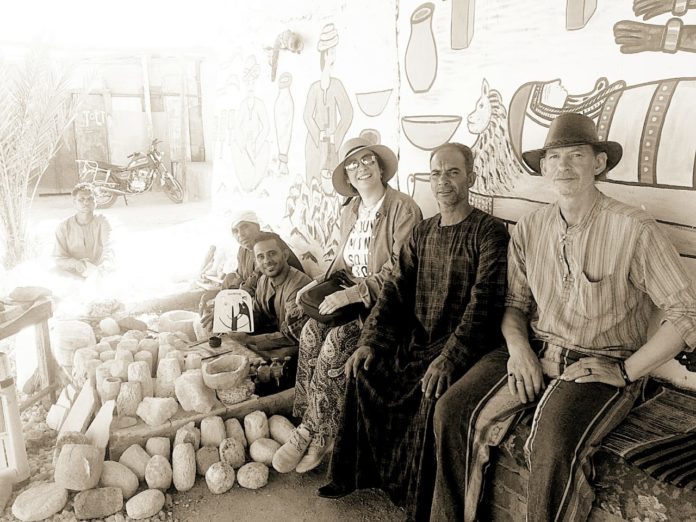On your way to visiting the memorable Valley of the Kings located on the west bank of the beautiful Luxor governorate, you will notice many shops of Alabaster manufacturing along the road. The shops are mostly named after our pharaonic ancestors whose temples, statues, tombs, reflect the greatness, power and mystery of a living civilization. MEO’s reporter Amira Elhamy, shares with us her visit to one of these shops at the Valley of the Kings..
At a shop, 5 minutes away from the iconic Hatshepsut temple, stands a dedicated Alabaster manufacturer who inherited his family business, which they started almost 100 years ago. Almost all workers working in the field of Alabaster manufacturing inherited the secrets and beauty of the handmade art craft that Pharos excelled in. Working with their own hands, molding, shaping, and reshaping the rocks to end up with beautiful sculptures, statues, candle holders remains a passion for their living and survival.
“I can do nothing for living except working with alabaster; it is my source of living that I inherited”. Said Gaber, the shop owner of the Alabaster store and factory.
“Our small location is divided into two parts; the open area where all the manufacturing tools and instruments are placed and where our workers develop the products and the second part is the shop where the end products are being displayed for customers.
Our work starts with collecting blocks of rocks from the mountains that surround us at the west bank. Alabaster comes in 3 colors: White, brown and green.
The first step is cutting the rocks into needed sizes, a process referred to as squaring, then the second step is reshaping the rocks using different techniques in the process turning them into round shapes, carving into three-dimensional sculptures, chiselling to produce low relief figures, accordingly, in order to give the roundness to the alabaster rock we use what is called “carving machine”, it is an instrument made of 4 iron wings that helps in creating the roundness of the rock, in case the product is an alabaster vase for example, the following step is folding the vase with a cotton piece of cloth that has some glue in it, this is because the rock has a degree of humidity in it that requires cotton to absorb the moisture. The next step is using an iron sharpening tool to give the smooth texture to the art craft. The following step is putting the art craft inside a special oven for a set time as per the product, then once out, we cover it with wax to give it a fair glow and elaborate finish that reveals its transparency, colour, and texture. After having the waxing process we start to draw exceptional designs with colours.” explains Gaber.
“The main materials I work with are: Alabaster, Granite, basalt, limestone and marble and each one needs a special manufacturing process.
We are able to draw on the limestone before putting it in a special oven, we make various products out of it, vases, plates, candle holders, ashtrays all using natural colors. We get our raw materials from rocks that are near Hatshepsut temple; it is a special kind of rock that looks plain from the outside, however it has colors unfolded inside it and in fact this is the type of rock that our ancestors used to get the colors from. As for the Granite, we usually get it from Aswan. As for the Basalt, this special kind of rock is characterized by the fact that it is very hard to break, we usually draw heliographic designs over it; and it comes in brown, grey and black.
Tourists usually prefer handmade manufactured limestone; it comes in white and in brown; we do various handmade designs and we focus on the pharaonic designs that tourists prefer. Our designs usually imitate the special drawings that are drawn on the temples and tombs’ walls.” notes Gaber.
“The manufacturing process nowadays is becoming more expensive due to increased costs. Mainly rock transport and salaries, the car that we use for the rock transporting process has raised prices from 3,000LE to 12,000LE, on the other hand, we had to raise salaries for workers and artists due to increased costs of living which has led to creating a financial burden as competition allows a minimum fraction of added costs to the sales prices. Yet, recently, we have had a good purchasing movement as the number of tourists who are coming to Luxor have increased lately.” said Gaber.
“There are lots of shops around me in this area, almost more than 100 shops/factories from the valley of the Queens till valley of the kings.” concludes Gaber.
Alabaster manufacturing factories, which are mainly present west Luxor governorate, mainly in Al Qurnah village or “El Kurna”, as locals spell it, used to produce 1000 alabaster art pieces each week; 70% of the art pieces were distributed in Luxor and 30% used to be distributed in Sharm El Sheik, Hurghada, and Marsa Alam. Following the COVID-19 pandemic, these percentages declined significantly. However, those in the business are having real hopes that the alabaster industry will pick up again.
Egypt currently is not on the map of Alabaster products exporting countries, although, about 100 shop in Luxour produce variable products of high quality and richness that can compete in the international markets.


















